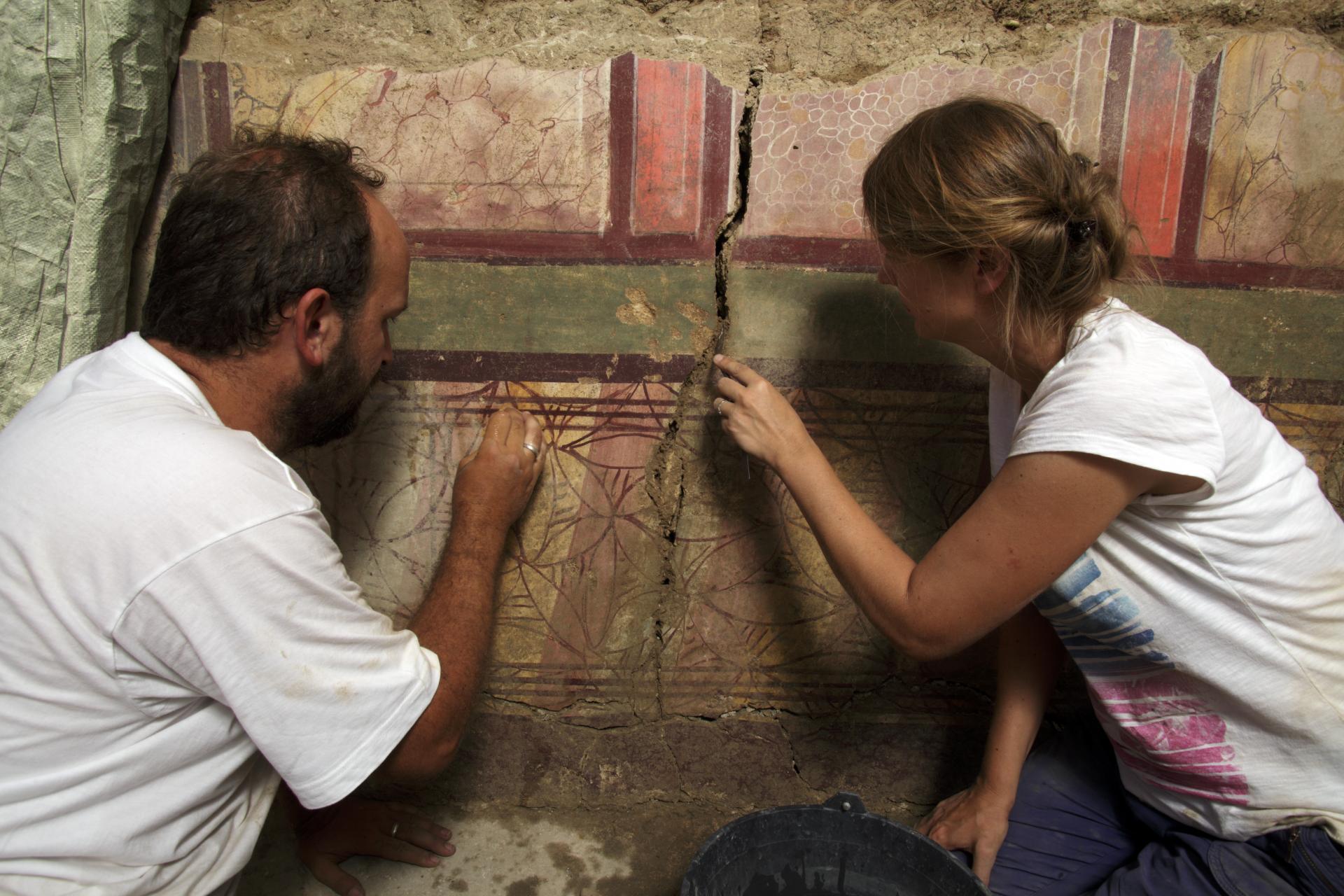
ongoing removal of the painted floor.
Read the original article about this project in the Roman portcity of Arelate (in French) here.
Translation
Located on the right bank of the Rhône, the site of La Verrerie, acquired by the city of Arles in 1978, has undergone several excavations revealing rich urban houses (or domus), abandoned following a fire, around 260 AD. The resumption of excavations by the Musée départemental Arles antique and the Inrap, between 2014 and 2017, has enabled the excavation of levels never before reached in this district and the uncovering of the House of the Harpist, whose luxurious frescoes are the subject of a vast programme of reassembly, study and restoration.
THE HARPIST'S HOUSE, A RICH ROMAN RESIDENCE
This Roman residence, named "the House of the Harpist" in reference to one of the characters painted on its walls and covering 105 m², is distinguished by its very early dating, its luxurious character and the exceptional state of preservation of its painted plaster.
It was built in the 70s and 50s BC, even before the creation of the colony of Arles, by craftsmen from Italy who built the house according to Roman construction techniques (masonry walls, tiles, floors made of briquettes placed in cobbles - opus spicatum - which were to become widespread in Gaul much later, in the 30s BC). This early dating shows that Arles was an important point of diffusion of new fashions and techniques throughout the provinces newly acquired from Rome.
Traditional in plan for a domus of the late Republic, its atrium comprises a gallery surrounding a rainwater collection basin (impluvium) and serves a series of rooms, two of which have been fully excavated. The decoration of the first room suggests a dining room or a bedroom. The second room, widely open onto the atrium and with sumptuous painted decorations, can only be a reception room. The house was destroyed between 50 and 40 B.C. and was filled in with its own rubble.
REASSEMBLING THE FRESCOES: A PUZZLE IN 800 BOXES OF FRAGMENTS
In a remarkable state of preservation, the paintings were both in place on the walls and in thousands of fragments that had collapsed into the fill levels. They fill 800 boxes. Within the framework of a partnership established in 2014 with Inrap, the study of this archaeological furniture has been entrusted to Julien Boislève, a toichographologist (specialist in wall paintings and stucco) from Inrap, in collaboration with the Museum's archaeologists and restorers. Since April 2021 and for a period of three years, these specialists have been studying and restoring the exceptional paintings in the Harpist's house.
Since April 2021, the reconstruction of the first decoration has been carried out in the heart of the museum, in the temporary exhibition room, where the fresco fragments cover more than 220 m². At the same time, the conservation and restoration workshop is carrying out the preliminary treatment of the painted walls taken from the site in order to make them accessible again for study. Research is also being carried out on the vermilion red in order to prevent its irremediable darkening. The study will soon continue in the Camargue at the Château d'Avignon (commune of Saintes-Maries-de-la-Mer).
EXCEPTIONAL PAINTED DECORATIONS
At this stage of the study, at least six decorations have been recognised, testifying to the ostentatious luxury developed by the owner. These paintings belong to the second Pompeian style. Only the richest patrons, steeped in Roman culture, had the necessary means to engage Italian workshops. Second style decorations are still rare in France and no other site has yet produced such a large, diversified and high quality collection.
The first room, studied this year, has an architecturally inspired decoration that divides the room into two distinct spaces (anteroom and alcove). Typical of this second Pompeian style, the ornamentation imitates large-scale architecture. The antechamber is predominantly yellow and the alcove is clearly highlighted by more elaborate ornamentation in much more vibrant colours. In the antechamber, the lower part of the wall imitates a grey marble podium supporting heavy yellow columns, while rows of coloured blocks occupy the upper part. In the alcove, the decoration is of the same inspiration but developed with a more luxurious polychromy. The brightly coloured podium is enhanced by rosettes in burgundy red. Rich panels of imitation marble veneers occupy the middle area, surmounted by rows of equally shimmering blocks, and a delicate frieze of hunting loves is inserted. This type of decoration corresponds to the only model of the second style found in Gaul up to now: about fifteen sites have less complete examples (Saint-Rémy-de-Provence, Nîmes, Narbonne, etc.).
The paintings in the ceremonial room will be studied in 2022. They include another type of decoration still unknown in Gaul: a gallery of large figures, including the harpist, positioned on pedestals and standing out against a vermilion red background. The musician is accompanied by other figures that probably belong to the Bacchic procession. This type of large-scale figuration is called "megalography". Rare examples representing characters on a vermilion red background are known in Italy, notably in the Villa of the Mysteries in Pompeii. In France, this type of decoration in such a state of preservation represents a real novelty.






 We are committed to providing versions of our articles and interviews in several languages, but our first language is English.
We are committed to providing versions of our articles and interviews in several languages, but our first language is English.